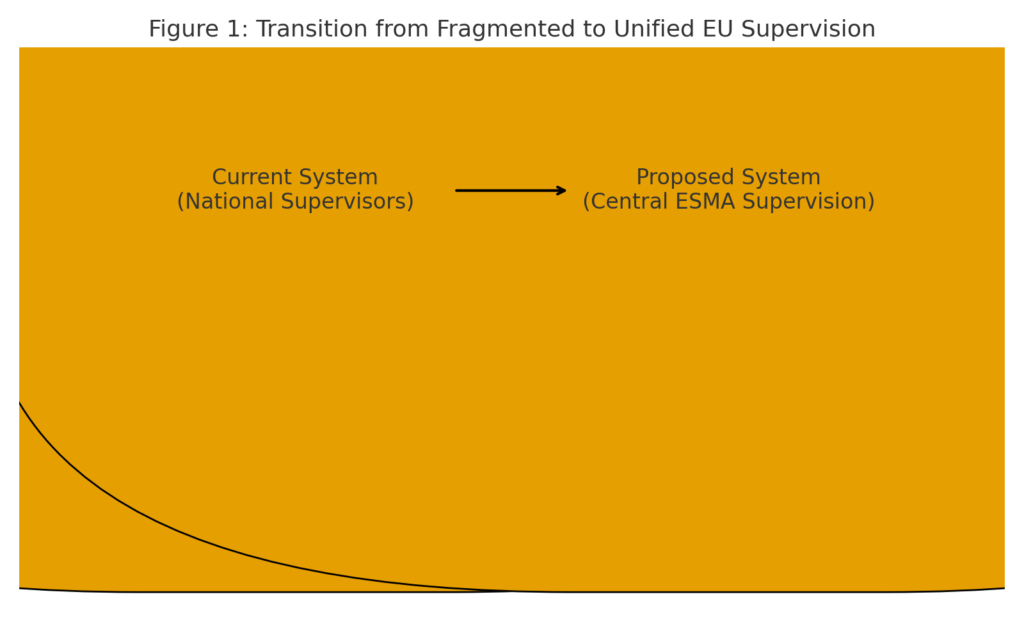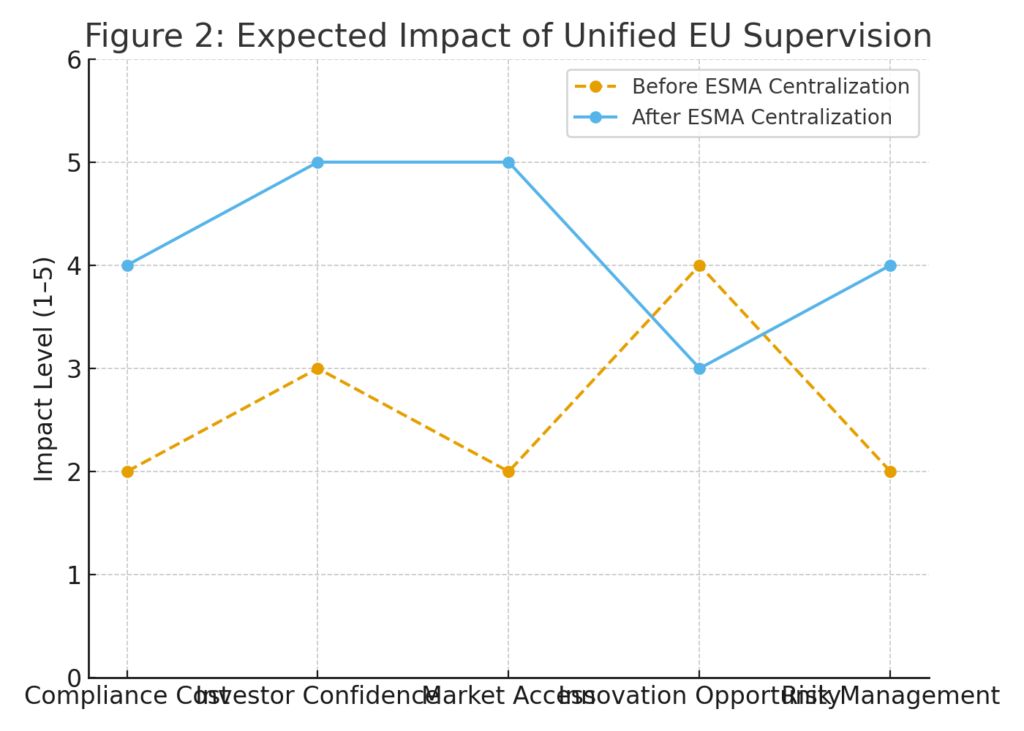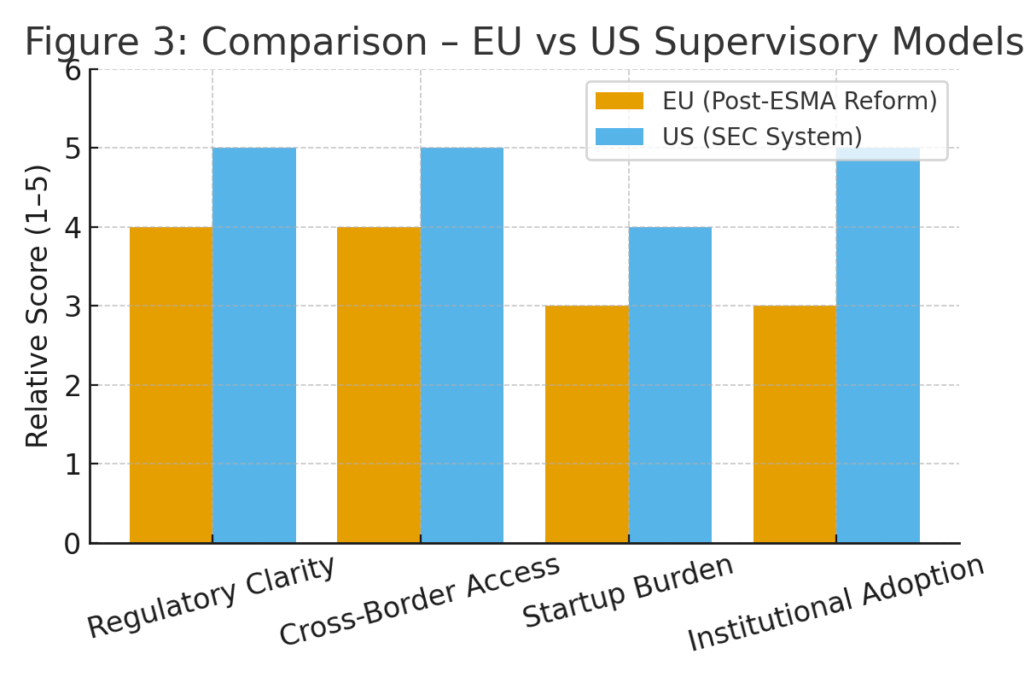
Main Points :
- The European Securities and Markets Authority (ESMA) is set to receive expanded powers to supervise stock exchanges, crypto exchanges and crypto-asset service providers across the European Commission (EC) member states.
- The move is motivated by fragmentation in EU capital markets and the desire to boost competitiveness relative to the U.S. Securities and Exchange Commission (SEC) regulated market.
- The regulation framework Markets in Crypto‑Assets Regulation (MiCA) formerly enabled a “passporting” model allowing crypto firms licensed in one EU member state to serve all 27 countries — but concerns about regulatory arbitrage have prompted calls for tighter oversight.
- For crypto-asset issuers, investors and innovators the shift signals both increased regulatory clarity and higher compliance burdens — presenting both opportunities and risks when seeking new revenue streams in blockchain.
- Start-ups and smaller players must re-evaluate their market strategies, as centralized supervision may reduce regional regulatory arbitrage but increase alignment cost and operational oversight.
- Ultimately, this change could reinforce Europe as a more unified digital asset market, benefitting investors looking for next-generation assets and blockchain use-cases, but successful players must anticipate evolving rule-sets and possible structural changes.
1. Background: Why Europe Seeks a Unified Regulator

Since its inception, ESMA has functioned as the EU’s independent authority for financial markets supervision, with mandates including investor protection, market stability and supervisory convergence. However, in the crypto-asset and exchange space Europe currently operates with 27 member states each hosting their own supervisory agencies. This fragmentation leads to inconsistent standards, cross-border friction and higher costs for firms operating across multiple jurisdictions.
As the Financial Times reports, the European Commission is drawing up plans to expand ESMA’s authority so that major exchanges and clearing houses — including those for cryptocurrencies — fall under a single supervisory umbrella. The rationale: by creating an “EU-version of the SEC” the bloc hopes to bolster its capital markets union and attract global finance and digital-asset innovation back to the continent.
For an audience seeking new crypto assets, this context matters. A more coherent European regulatory regime may lower uncertainty, simplify cross-border service provision and provide clearer guardrails for innovation. But it also means that nascent projects must be ready to meet more stringent oversight, especially if they aim for pan-European reach.
2. What’s Changing: The Shift in Supervisory Power
Expanded jurisdiction for ESMA
The proposed regulation would bring under ESMA’s direct supervision:
- Stock exchanges and crypto-asset exchanges operating cross-border in the EU.
- Crypto service providers (custody, trading platforms, advisory) that have systemic or cross-border importance.
- Other trading infrastructure, such as clearing houses, post-trade services, thereby closing loopholes for regulatory arbitrage.
Impact on “passporting” under MiCA
Under MiCA, which entered into force in December 2024, once a crypto-asset service provider is authorised in one EU member state, it can “passport” its licence across the EU. Some countries (notably France) argue this creates risk, as firms choose the least stringent regulator and then operate EU-wide. The move to centralize supervision addresses exactly this: making sure large firms cannot exploit jurisdictional arbitrage and that enforcement is consistent.
Timeline & key triggers
Reports indicate the draft proposal will be revealed by the Commission in December. Meanwhile ESMA chair Verena Ross has publicly supported the shift, saying a unified regime is a “step towards having a capital market in Europe that is more integrated and globally competitive.”
For new crypto-asset projects aiming for Europe, the window is now: projects must prepare for the regime change, anticipate stricter oversight, and align early rather than later.
3. Implications for Crypto Assets & Revenue Opportunities

For token issuers and blockchain application developers
- Clarity and scale: A unified regulator means one primary interface rather than 27 national ones. For projects issuing tokens or offering services across Europe, this could reduce complexity and expedite scaling.
- Higher compliance bar: The price of the scale is higher regulatory scrutiny. Projects must be ready for supervisor oversight that resembles banking / securities supervision more than light fintech sandbox regimes.
- Investor confidence: A strong supervisory regime may mean that institutional investors are more willing to engage with assets compliant in the EU, which may increase funding opportunities and secondary trading liquidity.
- Strategic design: Projects should revisit jurisdiction strategies. Smaller regional licences may no longer be sufficient, and early alignment with ESMA-style rules can become a market differentiator.
For investors and new assets seeking revenue
- The changing landscape signals that trusted platforms (those aligned early) could enjoy competitive advantage: e.g., receiving licences earlier, operating across EU, attracting institutional capital.
- Conversely, assets that rely on regulatory arbitrage or loose regimes may face increased risk: licence revocations, tightened enforcement, or being squeezed out of major EU markets.
- For blockchain use-cases (DeFi, tokenised real-world assets, crypto exchanges), the reforms can increase legitimacy — meaning novel models (e.g., asset-backed tokens) may find stronger institutional partner interest.
- From a revenue standpoint: projects aligned now may gain early mover advantage in Europe’s integrated market; those who delay may face higher “entry cost” and regulatory risk.
Opportunities and risks summary
Opportunities:
- Pan-EU access under unified supervision
- Increased institutional capital and ecosystem maturity
- Competitive differentiation for compliant projects
- Stronger trust, better tradeability, improved token liquidity
Risks:
- Higher compliance / regulatory cost
- Shorter regulatory leniency windows
- Potential exclusion of non-compliant projects from major European markets
- Strategic missteps if regulation evolves further
4. What It Means Practically for Stakeholders
Project teams (issuers, devs, start-ups)
- Begin mapping licensing / authorisation strategy now: Which regime will apply? Which threshold triggers ESMA supervision?
- Integrate compliance architecture early: KYC/AML, custody, auditing, reporting — these become foundational rather than optional.
- Choose market entry sequence wisely: EU may become a “clean” jurisdiction less tolerant of regulatory arbitrage; starting in a “lenient” state may not buy you long term scaling.
- Monitor regulation closely: December draft is upcoming; changes could shift the thresholds for what is “systemically important”.
Investors & asset hunters
- Use regulatory alignment as a filter: assets and platforms touting “EU licence” may be more credible if aligned with centralised supervision.
- Be aware of timeline risk: For projects launching pre-regime change, understand regulatory retrofit risk (will future audits/oversight change terms?).
- Consider geographical diversification: As EU becomes more regulated, other jurisdictions might be more permissive — but that comes with risk. Regulatory certainty is increasingly a competitive edge.
Blockchain applicators (business-use cases)
- Enterprise DLT and tokenised-asset programs may benefit: increasing regulatory clarity means that corporates and institutions are more comfortable engaging in digital assets in the EU.
- For tokenisation of real-world assets (RWA) or financial infrastructure, the unified regulator may also lead to clearer technical standards and interoperability expectations — beneficial for practitioners designing systems like wallets, settlement engines, DEX bridges.
- UX and transparency matter: as you design wallets or swap rails (for example your own project), you should assume that users will increasingly expect regulated service grade and cross-border clarity. Explicit mention of supervisory regime could be a UX trust indicator.

5. Next Steps & Strategic Takeaways
- Monitor the December proposal from the European Commission — anticipate the scope (which entities will be supervised), timing (when the changes become effective), thresholds (what makes a platform “systemic”).
- For token issuers: audit your business model for regulatory fit. Are you likely to fall under ESMA’s supervision? If yes: build in compliant controls now.
- For investors: track which assets/platforms are aligning early with EU regulation. These may be well positioned for the integrated European market.
- For wallet/platform developers: consider offering transparency around regulatory status (licence, location, supervision) as a user-trust differentiator. And design your UX assuming cross-border EU reach; central supervision may reduce friction but you still need multilingual, multi-jurisdiction awareness.
- Key message: regulatory clarity equals market access and trust — but it also equals cost and operational discipline. Choose your position wisely: are you a pioneer aligned with the new regime, or a fringe player hoping to exploit legacy arbitrage? The era of loose multiple-regulator overlap is likely shrinking.

